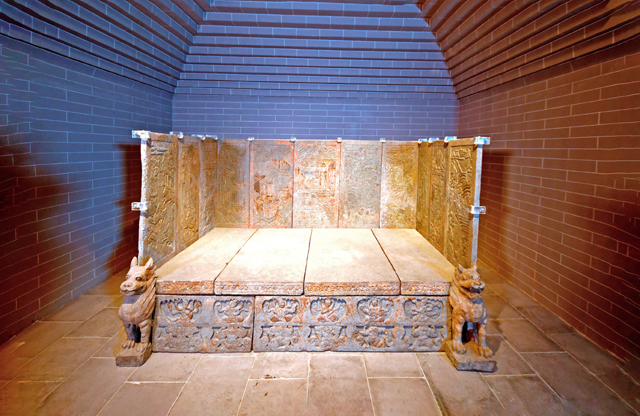|
This exhibition is a special display of gilded and color-painted screen-type sarcophagus of Sui Dynasty.
In June 1982, an ancient tomb was discovered at the top of Wenshan mountain near Shimaping village, Qinzhou district, Tianshui city. The tomb is faced to the north and is a single-chamber brick tomb in the shaft type. The screen-type sarcophagus is placed right in the middle of the chamber.
The sarcophagus is 2.18 meters long, 1.15 meters wide and 1.23 meters high. It is made of sand-shale stone. Its stand, panels and screen are composed of 17 stone reliefs and 8 raw stone slates of different sizes. The screen is composed of 11 color-painted stone reliefs. The left and right sides of the sarcophagus each consists of 3 panels and the front side includes 5 panels. On the screen, pictures of different activities of the tomb owner and others are engraved. Among them, the winemaking relief is related to the Sogdians' activities celebrating Zoroastrianism, and the reliefs featuring the sun and the moon on the left and right sides may reflect the sun and moon worship of Zoroastrianism.
The rectangular stand is composed of 8 raw stone slates of 33 cm in height and different lengths and 2 stone reliefs. The front stand is made up of two stone reliefs. The six sets of intagliated arched doors are divided into two levels. The arched doors on the upper level are in the shape of round bottom composed of lotus petals, with six male performers inside, and the lower level holds a mythical animal inside. There is also a crouched animal at the left and right feet of the sarcophagus.
The remaining items above and under the sarcophagus include 5 performer figurines in sitting positions, one chicken-headed bottle, one candlestick, one gold hairpin, one stone pillow, and one bronze mirror, etc. In addition, there is one tombstone bearing the epitaph of characters of 9 rows and 9 columns.
Sogdia refers to the region in the Central Asia where the Yilan-speaking Sogdians used to live in the Middle Ages. It is mainly located in the Zeravshan River basin between the Amu Darya and the Syr Darya in Central Asia. The Sogdians believe in the Zoroastrianism.
Judging from the luxury of the sarcophagus, the tomb owner should be an extremely rich Sogdian who had been highly assimilated by the Chinese.
|

